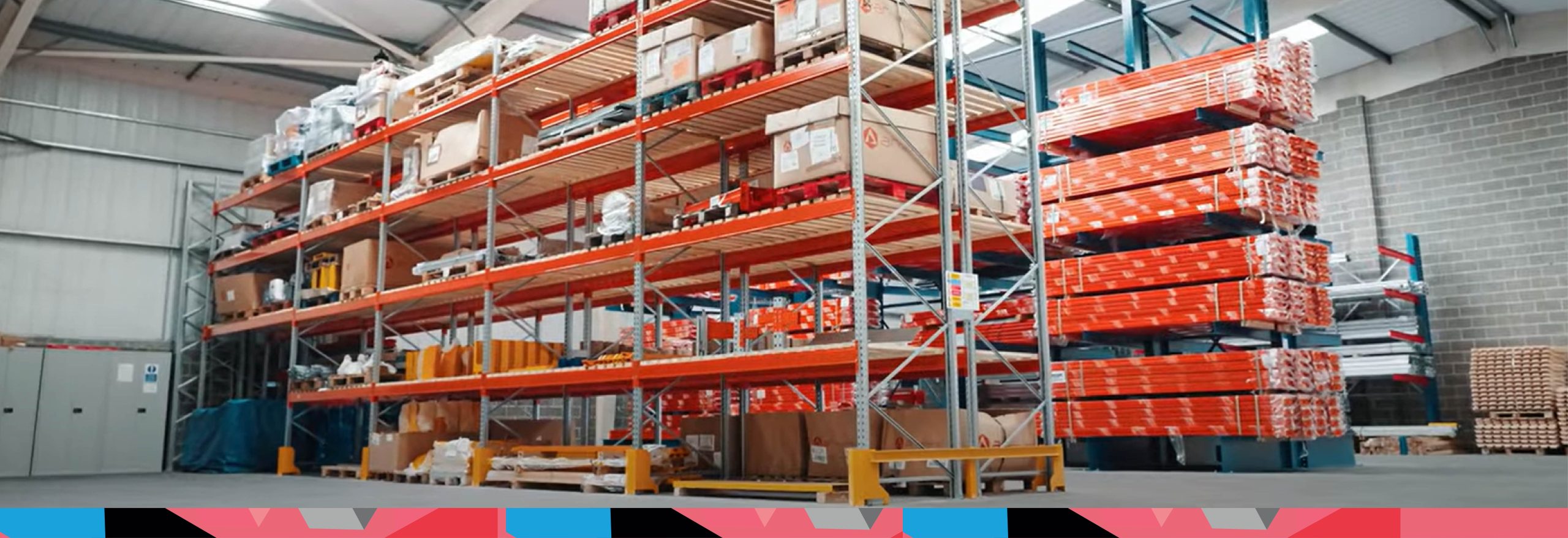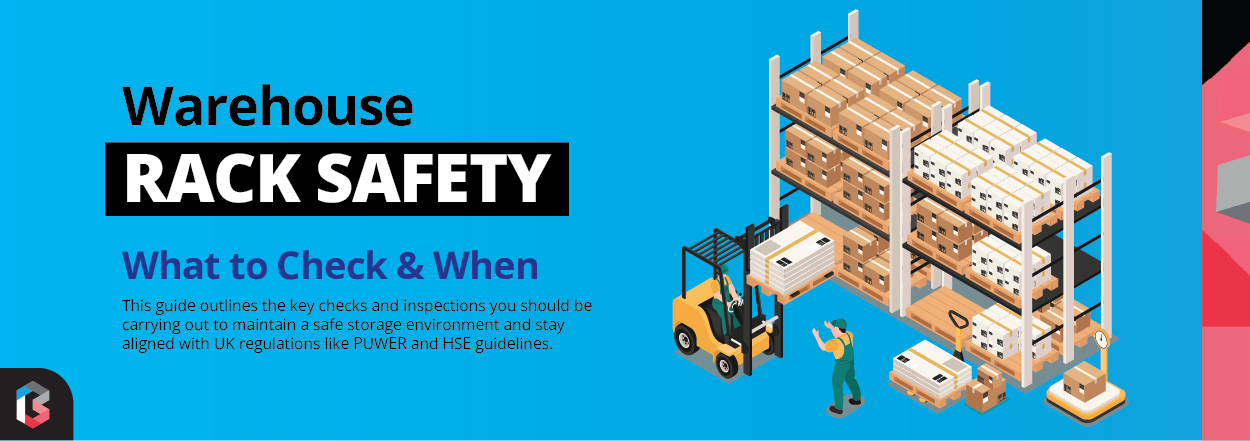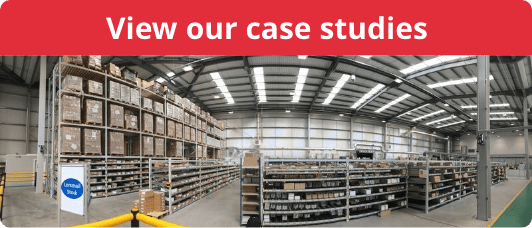Rack Safety Inspection Checklist: Green/Amber/Red Criteria Guide For Warehouse Racking Safety
If you run or manage a warehouse or storage facility, keeping your racking safe is about more than just ticking a compliance box. It’s about protecting your workers, your stock, and avoiding accidents that could disrupt operations, lead to costly repairs or become a risk to your employees safety. A dented beam or a missing beam lock may appear to be minimal damage, but ignoring it can put your business at risk.
This guide will walk you through the types of rack safety inspections you should be carrying out, as well as implementing the green, amber, and red system, showing you what to look for in each part of your racking and when to call in a SEMA approved rack inspector (SARI inspector).

Why Regular Rack Safety Inspections Are Essential
Warehouse racking takes a lot of daily wear and tear. Forklifts, pallets, and routine loading can cause damage that isn’t always immediately obvious. That’s why inspections should happen at different frequencies, with each serving a specific purpose:
- Ad-hoc checks - immediately after any impact or incident that may have damaged the racking. Quick visual checks catch urgent issues before they become serious. All users are responsible for reporting incidents and damage.
- Weekly visual checks – a routine walk-through to spot early signs of wear, leaning, dents, or missing components, recording findings on a structured check list to prevent minor issues from escalating. This is carried out by a Person Responsible for Racking Safety (PRRS).
- Annual inspections – a full, detailed assessment by a trained professional, such as a SARI inspector or qualified racking inspector, ensuring the racking meets safety standards and is fully compliant.
Legal requirements and compliance
In the UK, employers have a legal requirement under the Provision and Use of Work Equipment Regulations (PUWER) and the Health and Safety at Work Act 1974 to ensure storage equipment is safe and maintained for operation.
Following SEMA’s racking regulations and HSE guidance HSG76 helps demonstrate compliance with safety standards and good practice.
Health and safety responsibility
Beyond compliance, regular inspections are vital for maintaining a safe workplace and avoiding rack collapse - one of the most dangerous incidents in a warehouse environment.
A small but serious statistic
According to industry estimates, nearly 40% of warehouse accidents involve storage equipment. The vast majority could have been prevented through routine inspection, rack protection, and proper rack safety training.
For professional inspections or annual rack inspection services, see BSE UK’s racking inspection service.

Using the Green/Amber/Red Checklist System
The SEMA traffic light system helps warehouse operation managers prioritise repairs and maintenance quickly and clearly.
- Green: No or minor cosmetic damage – racking is safe to use, but should be monitored.
- Amber: Needs attention soon – isolate the bay of racking and repair before it worsens and causes an accident.
- Red: Serious damage - unload immediately and arrange rack repair or replacement with a credible supplier.
This system ensures that issues aren’t overlooked, helping you keep your pallet rack safety under control.
What to Check During Your Warehouse Racking Safety Inspection
Your warehouse racking safety inspection should be thorough, consistent, and ideally conducted by someone who understands the difference between minor wear and critical structural damage.
A SARI inspector or SEMA approved rack inspector can carry out a detailed annual assessment of your storage system, but you should also ensure you have trained members within your team for performing visual checks regularly.
Here’s what to focus on during a routine safety check.
Uprights & Frames
The uprights and frames form the backbone of your pallet racking system. A damaged component here can have serious consequences.
- Check for dents, twists, or buckling. Even a small dent - particularly near the base or bracing nodes - can weaken the entire structure.
- Use a depth gauge. As a rule of thumb, dents less than 3mm are generally classed as green, 3mm to 5mm as amber, and anything deeper than this or visibly bent as red.
- Look for rust, corrosion, or peeling paint. These could signal moisture damage or hidden steel fatigue.
- Ensure uprights are perfectly vertical. A leaning or misaligned frame could suggest a rack collapse risk or floor movement.
- Check frame connectors and bolts are tight, undamaged, and fully fitted.
If uprights have been struck by a forklift or pallet, isolate the area immediately and call a qualified racking inspector for assessment.
Beams & Safety Locking Pins
Beams carry the load, so any issue here needs close attention.
- Look for beam deflection (bending). Marginal flex under the load is normal, but permanent deflection when unloaded is not and needs reviewing.
- Check beam connectors for cracks, twists, or loose fixings.
- Ensure safety locking pins (beam connector locks) are installed on every beam end. Missing or damaged locking pins are a red level fault and must be replaced immediately.
- Check for paint cracks or flaking. These can indicate underlying stress or metal fatigue.
- If you see beams that have been moved or adjusted, confirm they are locked into their correct height with all safety features in place.
Remember, pallet rack safety depends heavily on beams being properly positioned and fitted, evenly loaded, and secure.
Baseplates & Anchors
Baseplates transfer the weight of the racking into the floor. If they fail, the whole system is compromised.
- Confirm all anchors are present and tight. Even a single missing bolt can destabilise a bay.
- Look for cracks around anchor bolts in the floor - these can suggest impact damage or floor settlement.
- Check for corrosion around anchor points and baseplates, particularly in older warehouses or areas prone to damp.
- Ensure shims (used to level racks on uneven floors) are properly installed and not crushed or displaced.
Missing or broken anchors automatically count as red-level defects - the bay should be unloaded and quarantined until repaired.
Bracing & Row Spacers
Bracing adds rigidity to your rack structure and prevents sway or collapse.
- Check for bent, twisted, or missing braces. Even slight bending can affect load distribution.
- Look for cracked welds or loose fasteners connecting the braces to uprights/posts.
- Inspect row spacers (especially on back-to-back installations) to ensure they’re secure and evenly spaced.
- Check for collisions or forklift contact around lower bracing - one of the most common causes of unseen structural weakness.
Bracing damage is often underestimated but is one of the most critical elements of safe racking design.
Rack Protection & Guards
Your rack protection - including column guards, end barriers, and pallet racking safety barriers - are designed to absorb impact before it reaches your steelwork.
- Check that all guards are in place and securely fixed.
- Look for crushed or heavily dented protectors. Once they’ve absorbed a single knock, they may need replacement.
- Verify that end-of-aisle barriers are correctly aligned and not obstructing walkways.
- Inspect floor fixings and bolts to ensure the guards haven’t shifted during collisions.
Well maintained protection systems are your first line of defence against rack damage from forklifts and pallet movement.
Decking & Pallets
The integrity of your decking and pallets directly affects warehouse racking safety. A weak pallet can fail suddenly, causing product spills or structural strain.
- Check timber, mesh, or steel decking for cracks, breaks, sagging, or corrosion.
- Ensure pallets are in good condition. Broken or splintered boards should be removed immediately.
- Avoid overhanging loads. Pallets should sit fully supported across both beams.
- Confirm pallets are suitable for the racking system (e.g. correct weight loading and size specified for the rack).
If you spot frequent pallet damage during your routine checks, it could be a sign of poor loading practices or a need for additional rack safety training.
Load Signs & Labels
Clear and consistent signage prevents accidental overloading and supports compliance.
- Ensure every bay and level displays a load sign.
- Check that information is accurate - maximum unit load, total bay load, manufacturer details, and inspection date.
- Replace faded or missing signs immediately.
- Ensure that operators are trained to understand the signage and never exceed safe working loads.
Missing or unclear signs are more than a paperwork issue, they’re a red flag for rack safety management.
Aisles, Clearances & General Environment
Your environment plays a major role in preventing rack damage and minimising workplace safety hazards.
- Keep aisles clear of pallets, debris, or packaging. Obstructions lead to collisions and poor forklift visibility.
- Maintain correct aisle width for your equipment type - narrow aisles often lead to rack contact.
- Ensure good lighting so damage is easier to spot during inspections.
- Check for roof leaks or dampness near racks - moisture can accelerate corrosion and weaken steel components.
- Inspect the floor condition regularly. Uneven or cracked flooring can lead to rack movement over time.
Even simple housekeeping and clear markings can drastically reduce the frequency of rack repair work.
Connections, Bolts & Accessories
Lastly, inspect every connection point, nut, and bolt.
- Tighten any loose fittings and check for missing fasteners.
- Check accessories like safety pins, spacers, and back stops are all secure.
- Inspect racking accessories and add-ons such as mesh panels or anti-collapse screens for signs of damage or missing fixings.
If your racking structure has been modified, extended, or reconfigured, ensure all new components meet SEMA safety standards and are compatible with the original system.
Green, Red & Amber Criteria Examples
This is a simplified summary of how certain types of rack damage are rated:
| Component | Green | Amber | Red |
|---|---|---|---|
| Upright dent depth | < 3mm | 3–5mm | > 5mm or visible bend |
| Beam deflection | < Span/200 | Span/200–Span/150 | > Span/150 or permanent deformation |
| Missing beam lock | None | 1 per bay | More than 1 or missing both ends |
| Baseplate anchors | All secure | 1 missing | 2+ missing or cracked base |
| Bracing | Minor scuffing | Bent but still in place | Broken, missing or detached |
| Load signage | Clear | Faded | Missing entirely |
You can also download our free racking inspection checklist to help guide your next weekly check.
Tagging, Isolating and Reporting Damage Found
When you identify damage, use a clear tagging and isolation system:
- Green: No immediate action - monitor during the next inspection.
- Amber: Label and schedule rack repair as soon as possible. Avoid loading the damaged bay until repairs or replacements have been carried out.
- Red: Unload immediately. Tag and isolate the area. Do not reload until a SARI inspector has approved it as safe.
Your inspection report should include all findings, repairs completed, and any ongoing monitoring notes. Regular documentation supports compliance and accountability.
When to Call an Expert
If you’re unsure whether damage is minor or serious, always err on the side of caution.
Call a qualified racking inspector if you find:
- Visible bends or leaning frames
- Repeated damage in the same area
- Unexplained floor cracks around baseplates
- Evidence of rack collapse or severe impact
Experts can assess damage, perform a rack replacement, or provide pallet racking repair services to restore safety.
FAQs
Q: How often should I inspect warehouse racking?
A: Carry out internal visual checks weekly, and a formal inspection by a SARI inspector or SEMA approved racking inspectors at least once a year. Ad-hoc checks should be carried out, with all operatives trained to understand signs of rack damage.
Q: Can I repair racking myself?
A: A warehouse owner may carry out only minor repairs in-house. For any structural issues, always use professional rack repair services.
Q: What are the signs of pallet rack damage?
A: Look for leaning frames, missing beam locks, cracked welds, damaged base plates or floor anchors, or impact marks near forklift routes.
Q: What’s the difference between amber and red damage?
A: Amber means the damage is significant but not yet critical; red means the structure is unsafe to use until repaired.

